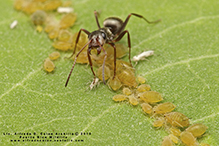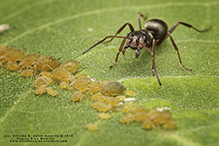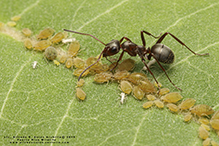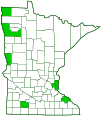Prairie mound ant
(Formica montana)
Conservation • Description • Habitat • Ecology • Distribution • Taxonomy
Conservation Status |
|||
| IUCN Red List | not listed |
||
| NatureServe | NNR - Unranked |
||
| Minnesota | not listed |
||
Description |
Prairie mound ant occurs in the United States in the upper Midwest and in the Great Plains states, and in southern Canada from Manitoba to Alberta. Workers are hairy, uniformly dark brown, and ¼″ to ⅜″ (6 to 9 mm) in length. Queens are 5 ⁄16″ to ½″ (8 to 12 mm) in length. The head is broadly rounded in outline. The rear margin is rounded, not distinctly concave. The eyes are large. The facial plate above the mouth (clypeus) is not notched. The finger-like sensory mouth part (maxillary palp) is long and has six segments. The basal segment of each antennae (scape) is very long, longer than the length of the head. There are numerous erect hairs on the under (ventral) side of the head, a few hairs on the side of the head extending just to the front edge of the eye, erect hairs at the back of the head at the edge (occipital angle), and usually no erect hairs on the cheek. There are no erect hairs on eyes or on the scape. The first body segment behind the head (mesosoma) has two distinct elevated areas (bumps). It is covered with three exoskeletal plates, the pronotum and mesonotum covering the thorax, and the propodeum covering the first segment of the abdomen that is fused to the thorax. The pronotum and mesonotum form one smooth convex bump, the propodeum a second convex bump. The second abdominal segment (petiole) is narrow and waist-like, and has a single raised bump (node). The remainder of the abdomen (gaster) is bulbous. The head, mesosoma, legs, and the gaster are covered with silvery appressed hairs. There are single rows of erect hairs at the end of each segment. The legs are brown. |
Size |
Worker: ¼″ to ⅜″ (6 to 9 mm) Queen: 5 ⁄16″ to ½″ (8 to 12 mm) |
Similar Species |
Habitat |
Prairies and meadows |
Ecology |
Season |
Spring to autumn |
Behavior |
|
Life Cycle |
A single mound may have many queens forming a supercolony. |
Larva Food |
|
Adult Food |
|
Distribution |
||
|
Sources Economo, Evan; Guénard, Benoit. "antmaps.org Formica obscuripes". antmaps.org. Okinawa Institute of Science and Technology. Retrieved 9 September 2025. |
|
| 9/25/2025 | ||
Occurrence |
||
Uncommon |
||
Taxonomy |
|
Order |
Hymenoptera (ants, bees, wasps, and sawflies) |
Suborder |
Apocrita (narrow-waisted wasps, ants, and bees) |
Infraorder |
Aculeata (ants, bees, and stinging wasps) |
Superfamily |
Formicoidea (ants) |
Family |
|
Subfamily |
Formicinae |
Tribe |
Formicini |
Genus |
|
no rank |
fusca group |
Subordinate Taxa |
|
|
|
Synonyms |
|
|
|
Common Names |
|
prairie mound ant |
|
taxonomy2col |
|
Synonyms |
|
|
|
Common Names |
|
|
|
Glossary
Clypeus
On insects, a hardened plate on the face above the upper lip (labrum).
Gaster
The bulbous part of the abdomen of ants, bees, and wasps. In ants it usually begins at segment three.
Mesosoma
In Hymenoptera: the front part of the body, consisting of all three segments of the thorax and the first segment of the abdomen, to which the wings are attached.
Pronotum
The exoskeletal plate on the upper side of the first segment of the thorax of an insect.
Propodeum
In Hymenoptera: the last segment of the thorax, anatomically the first segment of the abdomen.
Scape
In plants: An erect, leafless stalk growing from the rootstock and supporting a flower or a flower cluster. In insects: The basal segment of the antenna.
Visitor Photos
Share your photo of this insect.
This button not working for you?
Simply email us at info@MinnesotaSeasons.com.
Attach one or more photos and, if you like, a caption.
Alfredo Colon |
||
 |
 |
|
 |
||
MinnesotaSeasons.com Photos
|

Slideshows

Visitor Videos
Share your video of this insect.
This button not working for you?
Simply email us at info@MinnesotaSeasons.com.
Attach a video, a YouTube link, or a cloud storage link.
Other Videos



